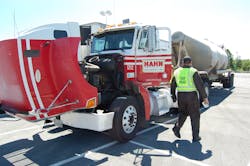Roadcheck 2012: Focus on hours and brakes
The annual three-day, commercial vehicle safety enforcement and education campaign dubbed Roadcheck, which is organized by the Commercial Vehicle Safety Alliance (CVSA), concluded yesterday after some 10,000 CVSA-certified local, state, provincial and federal inspectors at 1,500 locations in the U.S., Canada and Mexico performed commercial truck and bus inspections.
At this year’s event, inspectors paid increased attention to hours-of-service (HOS) and brake violations. In general, Roadcheck inspectors focus on the North American Standard (NAS) Level I inspection, HOS regs and rules for household goods (HHG) carriers.
CVSA executive director Stephen Kessler told FleetOwner that this year’s Roadcheck placed “extra emphasis” on out-of-service (OOS) violations pertaining to driver HOS and vehicle brakes because “trend data indicates these two areas have stagnated [in terms of CVSA not seeing these violations declining] as OOS defects. Both HOS and brakes are always part of a Level I inspection, but we decided it was important to key in on them even more this year.”
Keppler pointed out that Roadcheck is not all “stick” in its approach to highway safety, with the “carrot” being the various educational efforts that accompany the three-day event. “A lot of educational activities for fleets and drivers surround the enforcement effort,” he explained. “For example, educational literature is handed out to drivers during inspections and many fleets will do their own [Roadcheck] briefings with their drivers and managers.
“This year, we also put together and placed on our website a two-page ‘Driver Tipsheet’ of driving and vehicle safety advice to help them be safe and avoid committing violations,” Keppler advised.
Keppler noted that this time out extra scrutiny was also paid in several locales to truck operations serving the oil exploration and fracking industries. “There’s a violation trend [in this segment of trucking] and it has clearly increased in the last six months,” he said. “That led us to place greater focus on drivers and equipment serving those industries.”
Asked if this trend is resulting from willful violations from truck operators in this sector or from ignorance that might exist due to the high number of new entrants in this arena, Keppler responded that the answer may be some of both. But on the other hand, he noted that “for some areas, this is not a new development. One State has been conducting an enforcement effort for these trucks for three years and they still see a 40% OOS rate.”
While CVSA sponsors Roadcheck, participation in the event includes the Federal Motor Carrier Safety Administration, (FMCSA) Pipeline and Hazardous Materials Safety Administration, Transport Canada, Canadian Council of Motor Transport Administrators, and Mexico’s Secretaría de Comunicaciones y Transportes.
According to CVSA, during Roadcheck 2011 some 16 trucks or buses on average were inspected every minute for the 72 hours of the event. Drivers were pulled over or directed into weigh stations or other inspection locations and asked to show their commercial driver’s license, medical examiner’s certificate and record of duty status. Brakes, tires, lights and every major safety component of the truck or bus, plus proper load securement, were also examined.
Keppler said CVSA will be announcing the full results of Roadcheck 2012 during the first week of August.
Since its inception in 1988, the roadside inspections conducted during Roadcheck have numbered over one million and resulting in more than 220 lives saved and 4,045 injuries avoided, according to CVSA.. “It has also provided for the distribution of countless pieces of educational literature and safety events to educate industry and the general public about the importance of safe commercial vehicle operations and the roadside inspection program,” the Alliance noted.
